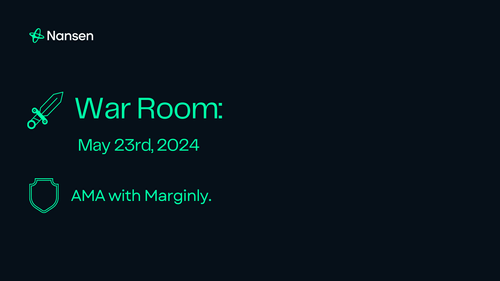Introduction
Centralized exchanges (CEXs) have long been the primary gateway for new participants entering the crypto world, especially as a retail on-ramp to access onchain applications. Since the merge, one of the flagship activities has been to stake Ether and use it in the broader DeFi landscape. From this core tenet of staking, an entire ecosystem has evolved, encompassing liquid staking tokens (LSTs), liquid restaking tokens (LRTs), and numerous other avenues for users to put their ETH at work in DeFi applications.
There will be dashboards referenced throughout the report. Some may be more favorable to follow along with the official dashboard links below:
Purpose of the Analysis
With the rapid expansion of the staking economy, our analysis delves into the net flows of ETH on CEXs. Since May 2021, ETH has consistently been moving off exchanges, as indicated in the data below.
Similarly, ETH flows on Coinbase reveal the same trend of net outflows.
Having peaked on February 27th, 2022, native ETH balances saw a 37.37% decrease compared to August 2024. However, these net flows focus solely on native ETH balances within CEX-labelled wallets and do not consider ETH 2 staking data. Consequently, these outflows also encompass movements to the staking deposit contract, which may remain under the CEXs’ control. Although classified as an outflow in the above charts, these ‘outflows’ may still be under the custody of CEXs. To provide a clearer picture, we incorporate staking data into our analysis to test the following hypotheses:
- CEXs’ market share of ETH has decreased due to a general move to onchain applications
- There has been a natural rise in ETH staking and CEXs’ market share of ETH holdings might have remained unchanged, as the staked assets have stayed under their custody
Scope Of the Report
This report is divided into two parts:
- Part One: Focuses on native ETH holdings and estimates the amount of ETH staked by each CEX on Ethereum.
- Part Two: Examines the flows of staking proxy tokens, including LSTs and LRTs, tracking where these flows’ destinations over time. This analysis is conducted at an entity-level granularity. Entities refer to specific participants or protocols like Uniswap or Aave.
- Additionally, this part includes a look at the top holders and top contributors of trading volumes of stETH on Ethereum.
Overall, this analysis aims to learn more about the role/trend of CEXs in the Ethereum network with respect to the staking economy and broader ETH use cases.
Methodology
We focus strictly on the Ethereum blockchain to help contextualize CEXs’ role in the staking economy and the broader onchain ecosystem. Building on Nansen’s CEX labels, we visualize onchain macro trends to test the hypotheses outlined in the scope section. We treat all CEX addresses similarly, without distinguishing between different types of addresses (e.g., deposit addresses vs. token channels).
As for the designated LSTs and LRTs for this analysis, we create a basket of the largest market cap tokens which include the following (in no particular order):
- cbETH
- eETH
- ETHX
- ezETH
- frxETH
- pufETH
- rETH
- rsETH
- rswETH
- sfrxETH
- stETH
- swETH
- weETH
- wstETH
- uniETH
Considering this token scope, we take monthly snapshots of balances at the end of each month and join the data with our comprehensive entity labels to show the top entities by USD balance over time.
Analysis and Findings
CEX ETH Flows
Staking has grown significantly, with over 34.1 million ETH staked at the time of writing. To illustrate this trend, we compare ETH balances on CEXs (excluding staking data) with the total amount of ETH staked.
It appears clearly that staking has been growing considerably and that ETH on CEXs is either being staked on behalf of its users or is being used for other onchain use cases. Let’s dive in.
CEX Daily Staking ETH 2 Balances
To calculate ETH staking balances of CEXs, our model assumes that depositor and withdrawer addresses are the same, matching onchain events and labels using public keys. This analysis does not account for staking rewards, so it approximates the amount of ETH being staked by CEXs over time.
Below, we visualize the amount of ETH staked by CEXs.
CEXs currently hold over 8.16 million ETH in staking, equivalent to more than $21.4 billion at the time of writing. This accounts for approximately 24% of all ETH staked, with a strong uptrend since 2021, peaking in mid-November 2023. The chart below further breaks down these figures by individual CEX.
Coinbase is the top CEX by ETH staked, with over 4.27m ETH staked as of mid-August 2024. Binance comes as a distant second, with 1.1m ETH, followed by third-ranked Kraken with 837k ETH staked. To better understand how Coinbase’s market share has evolved vs CEX competitors, we created the same chart but by CEX market share.
The combined view of native ETH holdings and staked ETH across CEXs is presented below.
CEXs: Staked ETH and Native ETH Holdings
Consistent net outflows from CEXs are visible, despite the increased popularity of staking. Although there has been a clear growth in ETH 2 staking by CEXs since 2021, the trend identified earlier remains intact, ETH continues to move off of CEXs. The total ETH balance on CEXs, including staked ETH, peaked at approximately 41.58 million ETH on September 14, 2022, prior to the collapse of FTX, and has since declined by about 20.86%. To better contextualize CEXs growth in staking relative to their native ETH balances, we made the below chart to show balances normalized to percentages.
By mid-August 2024, ETH staking balances represented approximately ~25% of CEXs’ total ETH balance (8.16m ETH out of 32.9m ETH). Although the majority of ETH remains in the ETH 1 balances, this suggests a significant shift towards Ethereum 2.0 over time, with the trend only growing.
As for Coinbase specifically, we observe a similar trend.
Coinbase shows net outflows since its peak in December 2023, down 19.26% with the outflows being notable for 2024. Next, we break down Coinbase’s ETH balances by ETH 1 and ETH 2 staking:
ETH staking makes up over 30.4% of Coinbase’s ETH balance, totaling over 4.28m ETH staked.
This view confirms that CEXs’ market share of ETH continues to decline due to a general shift to alternative onchain products. Despite their loss of market share, CEX-related staking continues to grow. Given the net outflows from CEXs, the next question is: What are these onchain alternatives for ETH, and what role do they play in the broader staking economy?
Flow of Staking Proxy Tokens
For this part of the analysis, staking proxy tokens are defined as any tokenized version of staked ETH. This includes LSTs like stETH and cbETH, as well as LRTs like ezETH. The objective is to identify the destinations of staking proxies to understand the underlying trends and how users are utilizing their ETH once staked. We analyze these flows across the entity-level granularity.
Entity Flows
We now turn our focus to the specific entities receiving these LSTs and LRTs flows.
The top 5 entities by USD holding as of August 2024 are:
- Lido Finance ($28,892,020,175.54)
- Aave ($5,397,689,397.53)
- Ether.fi ($4,661,436,580.69)
- EigenLayer ($3,026,625,123.52)
- Spark Protocol ($2,169,729,807.37)
While these entities hold the largest current balances, it’s also important to consider their growth trajectory in 2024 and over time. The top growing entities by USD balances in 2024 (YTD from January to July) are:
- Arbitrum - 591.58% increase ($375.21m)
- Morpho - 342.12% increase ($132.4m)
- EigenLayer - 202.45% increase ($3.02m)
- Pendle Finance - 99.57% increase ($793.73m)
- Aave - 82.16% increase ($5.39b)
Switching our focus to the largest staking proxy, let’s examine stETH on Ethereum.
Top Holders of stETH
As of July 2024, the stETH ecosystem is dominated by a few major players, with EigenLayer and Blast leading in total holdings (Lido Finance omitted). Top 5 largest holders of stETH as of mid-August 2024:
- EigenLayer: $2.33b USD
- Blast: $1.02b USD
- AO: $407.59m USD
- Aave: $296m USD
- wstETH is the dominant collateral on Aave
- ether.fi: $188.40m USD
The balance flows have experienced notable shifts in 2024, with some entities dramatically increasing their positions. EigenLayer, Blast, and AO have seen the largest increases. The largest balance increases in 2024 from January to August 2024 (Lido Finance omitted) are:
- EigenLayer: +$2.32b USD
- AO: +$403.46m USD
- ether.fi: +$236m USD
- MorpheusAI: +$165.86m USD
- Bybit: +$146.94m USD
Top Contributors of stETH Volumes
Switching gears, we now aim to answer, ‘Who are the largest contributors of stETH volumes on Ethereum?’ We utilize a dataset that provides a high-level overview of DEX trades which captures essential trade information such as trader address, tokens involved, volumes, etc. The main benefit of this dataset is to get a simplified analysis of DEX trading activity where it's easier to see and understand who is buying which token and by how much.
Although the analysis clarifies who is trading, it has some limitations. Particularly, this model only covers “atomic” trades (single-transaction trades), may not capture complex multi-transaction trades accurately (i.e. some limit orders), and is limited to trades where the sender and receiver are the same wallet address.
We will present the top addresses/entities by trade volumes for stETH and wstETH via monthly snapshots. The tokens included in this analysis are stETH and wstETH because we want to capture the most comprehensive trading picture and users may swap these two tokens interchangeably.
Factoring in the top 10 traders/entities by cumulative trading volume (USD), we get the following:
Any known entity will be tagged and others will appear as a normal wallet address. As of the last monthly snapshot (August 2024), Wintermute Market Making has been the leading contributor to stETH DEX volumes, with over $86 million in volume so far. The above chart just shows the top 10 contributors but we also provide a more extensive DEX trades table with many more traders on Ethereum.
The Ethereum staking economy has experienced significant growth, accompanied by a noticeable migration of ETH away from CEXs. Since September 2022, total ETH balances on CEXs have decreased by approximately 20.86%, despite an uptick in their staking activities. This decline underscores a broader shift towards onchain applications and decentralized custody.
In 2024, leading entities in ETH staking proxy balances include Lido Finance, Ether.fi, and Aave, all showing substantial growth. EigenLayer and Spark Protocol have also seen remarkable growth, reflecting the broader trend towards alternative staking solutions.
Regarding stETH, the largest holders—EigenLayer, Blast, AO, Aave, and Ether.fi—dominate the landscape, with EigenLayer alone seeing a $2.32 billion increase in 2024. Some of the top contributors to stETH trading volumes recently included Wintermute Market Making, Origin Protocol, and MEV-related wallets, underscoring the diverse trading environment around this key staking proxy.
In summary, this analysis confirms the ongoing rise in staking activity and the diversification of staking proxies across the Ethereum network, with a clear trend towards decentralized and alternative staking solutions.




